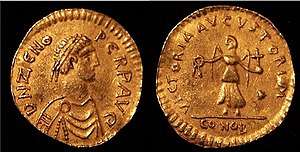474
Year 474 (CDLXXIV) was a common year starting on Tuesday (link will display the full calendar) of the Julian calendar. At the time, it was known as the Year of the Consulship of Leo without colleague (or, less frequently, year 1227 Ab urbe condita). The denomination 474 for this year has been used since the early medieval period, when the Anno Domini calendar era became the prevalent method in Europe for naming years.
| Millennium: | 1st millennium |
|---|---|
| Centuries: | |
| Decades: | |
| Years: |
|
| 474 by topic |
|---|
| Leaders |
| Categories |
|
| Gregorian calendar | 474 CDLXXIV |
| Ab urbe condita | 1227 |
| Assyrian calendar | 5224 |
| Balinese saka calendar | 395–396 |
| Bengali calendar | −119 |
| Berber calendar | 1424 |
| Buddhist calendar | 1018 |
| Burmese calendar | −164 |
| Byzantine calendar | 5982–5983 |
| Chinese calendar | 癸丑年 (Water Ox) 3170 or 3110 — to — 甲寅年 (Wood Tiger) 3171 or 3111 |
| Coptic calendar | 190–191 |
| Discordian calendar | 1640 |
| Ethiopian calendar | 466–467 |
| Hebrew calendar | 4234–4235 |
| Hindu calendars | |
| - Vikram Samvat | 530–531 |
| - Shaka Samvat | 395–396 |
| - Kali Yuga | 3574–3575 |
| Holocene calendar | 10474 |
| Iranian calendar | 148 BP – 147 BP |
| Islamic calendar | 153 BH – 152 BH |
| Javanese calendar | 359–360 |
| Julian calendar | 474 CDLXXIV |
| Korean calendar | 2807 |
| Minguo calendar | 1438 before ROC 民前1438年 |
| Nanakshahi calendar | −994 |
| Seleucid era | 785/786 AG |
| Thai solar calendar | 1016–1017 |
| Tibetan calendar | 阴水牛年 (female Water-Ox) 600 or 219 or −553 — to — 阳木虎年 (male Wood-Tiger) 601 or 220 or −552 |

Emperor Zeno (474–491)
Events
By place
Roman Empire
- January 18 – Emperor Leo I dies of dysentery at Constantinople, after a 17-year reign. He is succeeded by his 7-year-old grandson Leo II, who briefly becomes ruler of the Byzantine Empire.
- February 9 – Zeno, father of Leo II, is crowned as co-emperor (Augustus). He rules the empire together with his son and stabilises the Eastern frontier.
- June 24 – Julius Nepos arrives at Portus and marches on Ravenna. He forces Glycerius to abdicate the throne, and proclaims himself emperor of the Western Roman Empire.
- Glycerius is exiled to Dalmatia (Balkans) and becomes bishop of Salona. Neither the Senate nor the Gallo-Roman aristocracy decide to resist, and Nepos accepts the imperial purple.
- November 17 – Leo II dies of an unknown disease (possibly poisoned by his mother Ariadne) after a reign of 10 months. Zeno becomes sole emperor of the Eastern Empire.
- Winter – Zeno sends an embassy to conclude a peace with King Genseric. He succeeds in an agreement with the Vandals to secure the commercial routes in the Mediterranean.
By topic
Art
- A statue of a Standing Buddha from Sarnath, Uttar Pradesh, (during the Gupta period) is made. It is now kept at the Sarnath Museum (India). (Source states creation date 1st to 2nd century BCE.)
Births
- Abraham of Kratia, Christian monk and saint (approximate date)
- Anthemius of Tralles, Greek architect and mathematician (approximate date)
- Clotilde, Christian wife of Clovis I and ancestress of the succeeding Merovingian kings. (Approximate date) (d.545)
- Magnus Felix Ennodius, bishop and Latin poet (approximate date)
Deaths
- January 18 – Leo I, Byzantine Emperor (b. 401)
- November 17 – Leo II, Byzantine Emperor (b. 467)
- Theodemir, king of the Ostrogoths (approximate date)
gollark: Do you not care about random slow Windows updates or telemetry?
gollark: It has dubious security things - I think it sends off the key somewhere for recovery or something - and isn't as fine-grained as fscrypt.
gollark: That's been repurposed as a server, and will probably just have important data encrypted individually, since Linux lets you do that in a sane way.
gollark: I'm talking about my laptop. My desktop boots slower because weird old ASRock UEFI.
gollark: Yep!
References
This article is issued from Wikipedia. The text is licensed under Creative Commons - Attribution - Sharealike. Additional terms may apply for the media files.